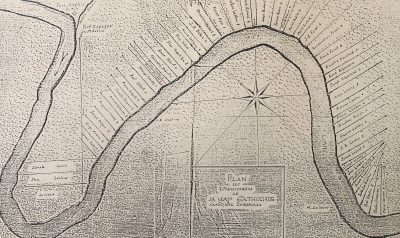Zerbine Was a Feisty Woman

Jeanne Zerbine Dupuy Landry Comeaux in 1864 in New Orleans, Louisiana. She lived in Brusly at the time.
I know it was just a few weeks ago that I posted this main photo, but I discovered a truly remarkable story about my great great great grandmother as a result of it. When I post photos and stories on my blog, I am always hopeful that it will stir some memory that someone will share. I don’t know everything about any of my ancestors – not by a long shot. So I always welcome comments and reminiscing about the posts that I share. That’s why I was so excited when the photo and story about Jeanne Zerbine Dupuy Landry unearthed a great treasure.
The family of one of Zerbine’s brothers passed down a story about her during the Civil War. But let’s look a little further back. When Zerbine was born in 1807, there was still a lot of Spanish influence in the area. The Dupuis family came to Louisiana as a result of Spanish rule inviting the Acadians to this area while providing land to live on. So when Jeanne Zerbine was named, her name was recorded as Juana Serbine. Even though I didn’t mention this in the first post about Zerbine, a distant relative found that document and made the connection with a story he had known since childhood.
Zerbine had an older brother by the name of Magloire – he was named after their father. The sibling born after her was a brother named Edouard. Zerbine and Edouard both married a Landry with common Hebert ancestors. Both couples had at least four children, but Zerbine was the only one that survived to the 1860s. Since the story I discovered was set around 1865, I decided to look to the Censuses to verify that she was indeed alive at the time and living in the same area.
Like I said in the first post, after Elie Onezime died, Zerbine married Valsin Comeaux. He also did not survive to the 1860s. But he left his name for Zerbine. In the 1850 Census she was listed as Z. Comeaux in the household of V. Comeaux in West Baton Rouge Parish. Also listed are her children Zulma and Pamelia – daughters by Elie Onezime Landry. There were no Comeaux children listed. Even though the last name was originally transcribed as Comeana, I found them when I looked up Zulma’s future husband Sosthene Aillet. They were listed directly under him.

My great great great grandmother is the first person listed on this page of the 1860 Census. Listed below her is the household of her niece.
It was equally difficult to find Zerbine in the 1860 Census. I searched Zerbine Comeaux, Juana Comeaux, and Jeanne Comeaux with no luck. I went through the West Baton Rouge pages one by one until I found what I was looking for. After reading through what seemed like a thousand pages, I found the listing for Wdw. Val Comeau. I know she was the widow of Valsin Comeaux, but couldn’t they put her name for once? Or at least spell her last name the traditional way?
At least I was able to verify that Zerbine Dupuy AKA Wdw. Val Comeau was alive and well in Brusly, Louisiana, in the 1860s. Everybody knows that the middle of the 1860s was defined by the Civil War. I’ve talked about her husband Onezime Landry’s nephews Trasimond and Alcide who fought for the Confederacy during that time. Brusly was in a state of unrest because the ports of New Orleans and Baton Rouge were controlled by the Union. During and after the war, Yankees were known to confiscate crops that had been harvested and animals for use as food or service.
Well one day a Yankee man showed up at the home of one Zerbine Comeaux. That’s right! Someone was visiting great great great grandma Juana, and it wasn’t a social call. He intended to make off with a horse from her property. Well Maman Juana was not going to put up with any more of these Yankee scoundrels running off with her hard-earned belongings. A horse made a big difference to the lives of people back then! So she put herself and her shotgun between that Yankee man and her horse. And I’m sure she had some choice words to say to him. Not that he would have understood what she was saying. She was probably speaking French or English with a strong French accent. But that didn’t keep him from understanding what she was trying to communicate to him. I suppose her firearm helped out with that! The Yankee left her property. The horse didn’t!
So that was the story passed down in the family of Juana/Zerbine’s brother Edouard. My fourth cousin once removed Edward says that when his sister would let her temper get the best of her, their mother would call her Juana. If I would have heard that when I was growing up, I would think they were talking about Aunt Wana. But that wouldn’t make sense because she did not have a temper. Though the sound of the name is the same, the spelling is different. Since Edward didn’t have an Aunt Wana, he wanted to know who this Juana was. Legend has it that the woman that looks so frail and sweet in that old 1864 photo was far from it. She was a rough lady who didn’t let anyone take advantage of her. That doesn’t sound like a bad thing at all. She got to keep her horse. Unless she got into legal trouble because of it. But we didn’t hear anything like that passed down. Yet it was passed down as a type of warning.
Warning or not, I like the story. Which is why I’m sharing it today. If anyone else has any old stories to share, just let me know. I’m all ears.







